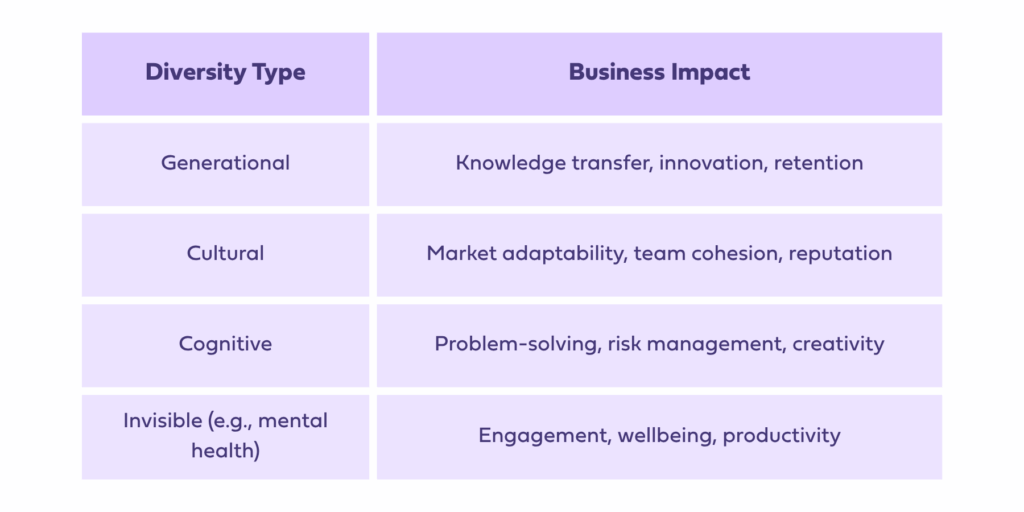Diversity, Equity and Inclusion (DEI) are more than corporate buzzwords. For modern organisations, they are strategic imperatives. Businesses that embed DEI into their operations see enhanced innovation, resilience, and financial performance. More importantly, they build workplaces where people from all backgrounds can thrive.
According to McKinsey’s 2025 report, organisations in the top quartile for ethnic and gender diversity on executive teams are 36% more likely to achieve above-average profitability. The CIPD emphasises that inclusive workplaces report higher engagement, stronger innovation and better retention of diverse talent. DEI is no longer a “nice to have” — it is fundamental to business success.
For HR professionals, DEI plays a central role in future-proofing organisations. This guide offers a deep dive into how DEI connects to performance, provides practical steps for embedding DEI into organisational strategy, and highlights best practices from leading organisations.
What Is Diversity, Equity and Inclusion (DEI)?
Diversity, Equity and Inclusion (DEI) are interconnected but distinct concepts. Understanding these distinctions is the foundation for building any meaningful DEI strategy.
Diversity relates to representation — it focuses on the presence of difference within an organisation’s workforce. This includes characteristics such as:
- Race and ethnicity
- Gender and gender identity
- Age
- Disability status
- Sexual orientation
- Socio-economic background
- Religious beliefs
At its simplest, diversity answers the question: Who is in the room?
Equity goes further than equality. While equality suggests everyone should receive the same opportunities, equity acknowledges existing disparities and actively works to remove systemic barriers. It ensures fair treatment, access, opportunity, and advancement for all individuals, recognising that some groups may require additional support to achieve fairness in outcomes.
Inclusion is about the lived experience of employees. It ensures that individuals — regardless of their background — feel welcomed, valued, respected, and able to contribute meaningfully. Inclusion is what transforms diversity from representation into meaningful participation.
Without all three — diversity, inclusion and equity — organisations risk superficial progress. Representation alone doesn’t create belonging, and inclusion without fairness will never deliver true engagement or retention.
Why DEI Is Often Bundled — But Should Be Treated Differently
Many organisations group DEI together, but in practice, these elements demand separate strategies and attention. Treating them as interchangeable leads to surface-level initiatives rather than impactful change.
How They Differ in Practice:
- Diversity: Focuses on recruitment, representation, and access to opportunities at every level.
- Inclusion: Concentrates on building psychologically safe environments where people feel empowered to contribute fully.
- Equity: Tackles structural inequalities through policies such as fair pay, transparent promotion processes, and adjustments for those facing systemic barriers.
For example, a company may hire more women (diversity), but if those women are excluded from decision-making (lack of inclusion) or face unequal pay (lack of equity), the DEI strategy will fail.
Current Trends of DEI (2025 and Beyond)
DEI strategies have evolved significantly in the past five years. Organisations now recognise the complexity of identities and the necessity of embedding DEI into core business functions, not treating it as a standalone initiative.
- Intersectionality: Recognising overlapping identities (e.g., race, gender, disability) and how these affect inclusion or discrimination. Modern DEI strategies address these intersecting barriers holistically.
- Neurodiversity as a Strength: Valuing cognitive differences (such as autism, ADHD, dyslexia) as assets rather than limitations, adapting recruitment and workplace environments to unlock this potential.
- Integration with ESG Goals: DEI is now viewed as integral to the ‘Social’ pillar of ESG (Environmental, Social, Governance) strategies. Investors, regulators, and consumers expect organisations to report on workforce diversity and inclusion outcomes alongside environmental impact.
- Technology and AI: AI-driven recruitment tools can reduce bias but also risk perpetuating existing inequalities if poorly designed. Ethical AI use is now a DEI concern, ensuring algorithms are transparent, fair, and regularly audited.
Forward-thinking organisations that embed these trends now will future-proof their DEI efforts and strengthen their position in talent attraction, innovation, and ethical leadership.
Why DEI Matters in Modern Workplaces
Diversity, Equity and Inclusion (DEI) are now recognised as strategic imperatives for modern organisations. While DEI initiatives were once driven primarily by compliance or corporate responsibility, today their commercial value is well-established. Inclusive organisations consistently outperform their competitors across key business metrics, from profitability to innovation and employee retention. According to McKinsey, companies with diverse leadership teams are 36% more likely to achieve above-average profitability.
How Inclusion Drives Performance
Inclusion is a catalyst for unlocking the benefits of diversity. Without an inclusive culture, representation alone fails to drive results. Inclusion strengthens organisational performance through three key levers:
- Employee Engagement: Inclusive workplaces report higher levels of trust, job satisfaction, and discretionary effort. Employees who feel valued are more motivated and loyal.
- Retention: Belonging is a powerful retention tool. Employees who see themselves represented and respected are less likely to leave, reducing turnover costs and preserving institutional knowledge.
- Innovation: Inclusive cultures encourage psychological safety, where individuals feel free to contribute ideas without fear of judgement. This drives creativity, problem-solving and continuous improvement.
Real-World Examples of DEI Impact
Google has integrated inclusion deeply into its product design by releasing Real Tone and the Monk Skin Tone (MST) Scale, which aim to eliminate bias in AI systems—especially those involving photography. The MST Scale comprises 10 skin-tone shades and is now used to train image recognition models, leading to ’Real Tone’ camera enhancements that deliver more accurate rendering of darker skin tones on Google Pixel devices. As a result, users across all skin tones are captured authentically, enhancing product reliability and user experience.
NatWest
NatWest has committed to achieving gender-balanced leadership, setting a target of 50% female representation within its senior leadership (CEO-2) by 2030. The bank ensures accountability by tying executive performance metrics—and in some cases remuneration—to progress on these DEI goals . As of 2021, NatWest reported that half of its total workforce was female, marking steady progress in gender representation at all levels.
NHS
NHS
NHS Trusts have made DEI a strategic priority—linked closely to improving staff experience, retention, and patient outcomes. The NHS England EDI Improvement Plan (2023) mandates six high-impact actions, such as inclusive recruitment and leadership accountability, designed to foster belonging and health equity across the system.
The Difference Between Diversity, Inclusion and Equity
For HR leaders, understanding the distinction between diversity, inclusion and equity is fundamental to building meaningful DEI strategies. Although these concepts are often discussed together, they serve very different purposes within an organisation and require targeted action.
Common misunderstandings include:
- Diversity ≠ Inclusion: Simply having a diverse workforce does not ensure people feel included. Without a culture of belonging, representation alone cannot unlock the benefits of diversity.
- Equity ≠ Equality: Equality provides everyone with the same resources or opportunities, assuming a level playing field. Equity recognises that barriers exist and provides tailored support to achieve fair and meaningful outcomes.
Organisations often overestimate progress by focusing on headcount diversity alone, while failing to address structural inequities or the lived experience of inclusion.
Why Each Requires a Distinct Strategy
Achieving progress across all three areas demands deliberate, differentiated approaches aligned to business strategy:
Diversity
- Expand outreach to underrepresented talent pools
- Use diverse hiring panels to reduce bias
- Write inclusive, accessible job descriptions
Inclusion
- Develop leadership behaviours that foster belonging
- Create psychologically safe environments
- Support employee resource groups (ERGs) to amplify marginalised voices
Equity
- Conduct regular pay gap analyses (gender, ethnicity, disability)
- Review promotion and performance processes for fairness
- Provide targeted accommodations and development opportunities
An organisation may achieve diversity targets by increasing the number of women in technical roles. However, if these women face barriers to career progression (an equity issue) or feel excluded from key decision-making processes (an inclusion issue), the DEI strategy is incomplete and unsustainable.
Treat Diversity, Equity and Inclusion as three interdependent but distinct workstreams — each requiring clear ownership, resource investment, and measurable outcomes.
Types of Diversity in the Workplace (With Examples)
In the UK, the Equality Act 2010 provides a legal framework to protect individuals from discrimination in the workplace based on nine protected characteristics. These are considered foundational to any DEI strategy but should be viewed as a minimum standard, not the endpoint for organisations aiming to lead on inclusion.
The protected characteristics are:
- Age
- Disability
- Gender reassignment
- Marriage and civil partnership
- Pregnancy and maternity
- Race
- Religion or belief
- Sex
- Sexual orientation
HR Implication: Compliance alone does not guarantee inclusion. True DEI strategies move beyond protection to actively create equitable opportunities for all.
Visible and Invisible Diversity
Visible diversity typically refers to characteristics that are outwardly recognisable, such as gender, ethnicity, or age. These are often the focus of early-stage DEI efforts, partly because they are easier to track through data.
Invisible diversity encompasses characteristics and experiences that are less immediately obvious but deeply impactful on an individual’s workplace experience. These include:
- Neurodiversity: Autism, ADHD, dyslexia — bringing unique cognitive strengths but often requiring specific adjustments.
- Mental health conditions: Anxiety, depression, PTSD — areas where stigma still influences inclusion.
- Socio-economic background: Experiences of poverty, education access, or class status that shape opportunities and confidence.
- Caring responsibilities: Parents, carers of elderly relatives or dependents — influencing work-life balance, flexibility needs, and career progression.
Many exclusionary practices are unintentionally reinforced when organisations focus solely on visible diversity metrics. True inclusion requires policies and cultures that acknowledge the full spectrum of employee experiences, visible or not.
Broader, Strategic Categories of Workplace Diversity
Leading organisations expand beyond legal definitions to embrace diversity as a business strength, encompassing a wider set of characteristics that influence team dynamics, leadership styles, and innovation capability.
Generational Diversity
Workforces today span up to five generations. Each cohort brings different expectations around work, leadership, communication, and values.
Implication for HR:
- Tailor engagement strategies and learning pathways.
- Address generational bias in talent decisions (e.g., assumptions about tech skills or ambition).
Cultural and Global Diversity
In increasingly global markets, cultural fluency enhances collaboration and customer relevance.
Implication for HR:
- Invest in cultural competence training.
- Align policies to accommodate religious, cultural, and language differences.
Cognitive Diversity
Teams benefit from varied problem-solving approaches, decision-making styles, and thinking patterns — often linked to neurodiversity but also shaped by professional background, education, and life experience.
Implication for HR:
- Encourage cross-disciplinary collaboration.
- Foster environments where difference in thinking is valued, not marginalised.
The Strategic Benefits of Embracing the Full Spectrum of Diversity

A nuanced understanding of diversity supports more effective talent strategies, enhances employee experience, and strengthens organisational resilience.
What HR Professionals Should Do Next: Move beyond compliance checklists and diversity headcounts. A future-ready DEI strategy must actively embrace the full spectrum of human diversity — embedding it across recruitment, career progression, learning and development, wellbeing, and leadership. This isn’t just an ethical priority; it’s a catalyst for unlocking your workforce’s full potential.
Building a DEI Strategy That Works
1. Assessing Your Current State
Before setting goals, organisations must understand their starting point. A DEI audit should consider:
- Workforce demographics across departments and levels
- Pay gap data (gender, ethnicity, disability)
- Recruitment and promotion trends
- Engagement survey results focusing on inclusion and belonging
Use both quantitative data and qualitative insights from employee resource groups (ERGs) or focus groups to paint a full picture.
2. Setting Goals and KPIs
Effective DEI goals are SMART (Specific, Measurable, Achievable, Relevant, Time-bound) and aligned to business outcomes:
- Increase representation of Black and ethnic minority leaders by 10% over five years
- Close the gender pay gap within a defined timeframe
- Improve inclusion scores on engagement surveys by 15%
Establish clear accountability for these goals within leadership structures.
3. Integrating DEI with L&D Strategy
Learning and Development (L&D) should underpin DEI strategies:
- Inclusive leadership training
- Unconscious bias workshops with actionable outputs
- Sponsorship and mentorship programmes for underrepresented groups
- Tailored career pathways linked to progression opportunities
4. Holding Leaders Accountable
DEI success hinges on leadership ownership:
- Embed DEI KPIs into performance reviews for senior leaders
- Provide regular DEI progress updates to boards and stakeholders
- Link DEI outcomes to incentives where appropriate
Embedding DEI into Learning and Development (L&D)
Inclusive Leadership Training
Inclusive leadership is a key driver of sustainable DEI. Leaders need the skills, awareness and confidence to foster inclusive cultures:
- Unconscious Bias Training: Helping leaders recognise and mitigate bias in decision-making processes.
- Psychological Safety: Creating environments where individuals feel safe to share ideas and challenge norms.
- Empathy and Active Listening: Building trust through authentic communication and understanding.
Bias Awareness Programmes
Moving beyond one-off workshops, effective programmes embed bias awareness into the organisation’s culture:
- Regular, Practical Workshops: Using real-life scenarios to highlight unconscious bias.
- Bias Interrupters: Practical tools to remove bias from hiring, promotion and reward processes.
- Feedback Loops: Mechanisms for employees to safely highlight instances where bias may have occurred.
Career Pathways for Diverse Talent
Ensuring career progression opportunities for underrepresented groups strengthens retention and widens leadership pipelines:
- Structured Mentoring and Sponsorship: Connecting diverse talent with senior advocates.
- Transparent Criteria: Clear promotion processes help mitigate bias.
- Skills Development: Tailored learning opportunities aligned to leadership competencies.
Common Barriers to Inclusion (And How to Overcome Them)
Common Organisational Challenges
Even well-intentioned organisations face obstacles:
- Viewing DEI as an HR issue only: Success requires organisation-wide ownership.
- Tokenism: Focusing solely on diversity metrics without creating inclusive cultures.
- Inconsistent Leadership Commitment: Leaders must model inclusive behaviours consistently.
- Underfunding DEI Initiatives: DEI needs adequate resources, not lip service.
Practical Solutions
Organisations can overcome barriers with proactive strategies:
- Embed DEI in Core Strategy: Align DEI with organisational goals and values.
- Upskill Leadership: Provide training, tools and accountability mechanisms.
- Empower Employee Networks: Support ERGs to drive change from within.
- Transparent Reporting: Share progress openly to build trust and accountability.
Shifting Mindsets and Behaviours
Sustainable inclusion requires cultural change:
- Psychological Safety: Foster open, respectful communication.
- Lived Experiences: Encourage storytelling to build empathy.
- Recognise Progress: Celebrate milestones to maintain momentum.
Action Point: Address both systemic and behavioural barriers to inclusion simultaneously.
Measuring the Impact of DEI
Measurement is one of the most overlooked — yet critical — elements of a successful DEI strategy. Without robust, transparent measurement, organisations risk overestimating their progress, missing systemic issues, or failing to demonstrate the business value of DEI to leadership and stakeholders.
Key Metrics for Success
Effective DEI measurement blends quantitative data (the ‘what’) with qualitative insights (the ‘why and how’). Together, these provide a richer, more accurate picture of organisational progress.
Core metrics to include
Representation Data:
- Workforce demographics segmented by role, level, department, and location.
- Focus on intersections — for example, women of colour in leadership, not just ‘women’ or ‘ethnicity’ in isolation.
Pay Gap Analysis:
- Regular audits of gender, ethnicity, and disability pay gaps.
- Analysis of bonuses, benefits, and reward schemes, not just base salary.
Engagement and Inclusion Surveys
- Metrics on belonging, psychological safety, inclusion, trust in leadership, and access to opportunity.
- Segmented by demographics to identify disparities in experience.
Retention, Promotion, and Attrition Rates
- Broken down by demographic groups to expose any systemic inequalities in progression or turnover.
Good Practice for HR
Leading organisations publish annual or bi-annual DEI Impact Reports that provide transparency and demonstrate commitment. These typically include:
- Clear progress updates against goals.
- Honest reflections on challenges and setbacks.
- Future priorities and areas for renewed focus.
Such transparency builds trust with employees, customers, investors, and regulators — and signals maturity and accountability in DEI leadership.
The Role of Leadership in Driving DEI Success
Leadership commitment is the single most critical factor in whether DEI efforts succeed or stall. Employees and stakeholders watch leaders’ behaviours — not just their words. Leaders set the tone for organisational culture, priorities, and accountability.
Core behaviours of leaders who drive DEI progress
- Authenticity: Sharing personal commitments, learning journeys, and reflections on privilege or bias helps build trust and credibility.
- Accountability: Holding themselves and others — responsible for achieving DEI outcomes, not just activities.
- Visibility: Actively engaging with ERGs, DEI initiatives, and employee forums signals that inclusion is valued and prioritised.
Leadership sets the tone: When leaders model inclusive behaviours, inclusion becomes embedded in the organisational DNA — not confined to HR alone.
Common Pitfalls to Avoid
Even well-intentioned leaders can undermine DEI efforts through these missteps:
- Delegating DEI solely to HR: This signals it is optional or peripheral rather than central to business strategy.
- Prioritising optics over impact: Token gestures erode trust and credibility.
- Inconsistent messaging or behaviours: Mixed signals from leadership undermine cultural change.
Lesson for HR: Leadership accountability is non-negotiable for meaningful, sustainable DEI progress.
Communicating DEI Internally and Externally
Internal Communication Strategies
Effective internal communication ensures DEI remains visible, understood, and connected to organisational values.
Best practices:
- Regular updates: Share honest progress reports and clear next steps.
- Storytelling: Highlight real employee experiences to humanise data and inspire engagement.
- Open dialogue opportunities: Facilitate safe spaces for discussion, feedback, and challenge.
Insight: Employees engage more with DEI when they see tangible progress and feel their voices matter.
External Communication Best Practices
External communication should reflect authentic culture, not marketing spin. Transparency builds trust with candidates, customers, investors, and wider stakeholders.
Key principles:
- Honesty: Share both achievements and areas where more work is needed.
- Authenticity: Align employer branding with lived employee experiences, not just aspirations.
- Substance over statements: Demonstrate action through policies, reporting, and leadership behaviour.
Action Point: Communication shapes perceptions — ensure it is clear, consistent, and evidence-based.
Embedding Inclusion in Culture
Inclusion cannot succeed as a standalone initiative; it must be woven into the fabric of how an organisation operates, makes decisions, and recognises success.
Embedding practices:
- Align DEI with core values and behaviours expected of all employees.
- Incorporate inclusive behaviours into competency frameworks and performance management.
- Recognise and reward contributions to inclusion, not just commercial outcomes.
Supporting Psychological Safety
Psychological safety underpins innovation, wellbeing, and inclusion. It enables people to speak up, share ideas, and challenge bias without fear.
How to build it:
- Train leaders to foster open, respectful dialogue.
- Address exclusionary behaviours consistently and fairly.
- Reinforce zero tolerance for harassment, discrimination, or bullying.
Insight: Without psychological safety, DEI cannot take root at a cultural level.
The Future of DEI in HR and Business Strategy
1. Stronger Integration with ESG (Environmental, Social, Governance)
DEI is increasingly recognised as integral to the ‘Social’ component of ESG reporting. Investors, regulators, and consumers expect organisations to disclose progress on workforce diversity, inclusion practices, and equity outcomes alongside environmental and governance measures.
2. Inclusive Technology and Ethical AI
As AI becomes embedded in recruitment, performance management, and learning tools, organisations must actively mitigate algorithmic bias and prioritise accessibility. Inclusive technology is no longer optional; it is critical for fairness and compliance.
3. Data-Driven Decision Making
Advanced people analytics are empowering organisations to move beyond descriptive metrics to predictive insights. Data on representation, inclusion, and equity is informing talent strategies, succession planning, and cultural interventions.
4. Rising Employee Expectations
Younger generations demand transparency, authenticity, and action from employers on DEI. Organisational credibility increasingly depends on visible, measurable progress, not performative statements.
The priority for HR: Embedding DEI as a fundamental business capability is essential for building resilience, adaptability, and maintaining a competitive edge in a rapidly changing world.
Where to Go Next with DEI
Diversity, Equity and Inclusion is not a destination to be reached; it is an ongoing journey, shaped by leadership, embedded in culture, and measured through accountability. For HR professionals and business leaders, DEI represents both a challenge and a significant opportunity: to build workplaces where people and organisations can truly thrive.
Explore Further with Avado
At Avado, we support HR professionals to lead on DEI through future-focused learning and development.
- CIPD Level 3: The CIPD Level 3 Certificate in People Practice is perfect for those beginning their HR or L&D journey.
- CIPD Level 5: The CIPD Level 5 Associate Diploma in People Management helps experienced HR professionals deepen their expertise and drive more impactful outcomes.
- CIPD Level 5 L&D: The CIPD Level 5 Diploma in Organisational Learning and Development supports L&D practitioners aiming to lead change and build learning cultures.
- CIPD Level 7: The CIPD Level 7 Advanced Diploma empowers senior HR leaders to influence business strategy and shape the future of work.
Equip yourself and your organisation with the knowledge and skills to drive meaningful, sustainable change.

 17 min read
17 min read 



